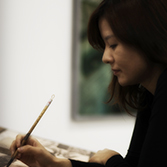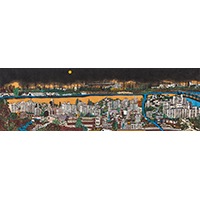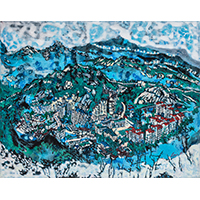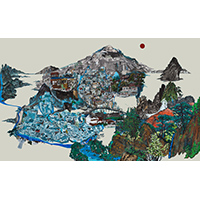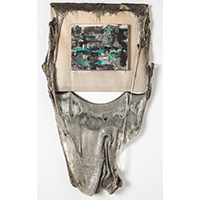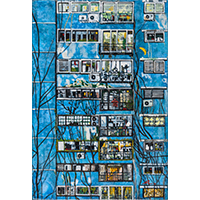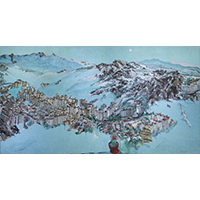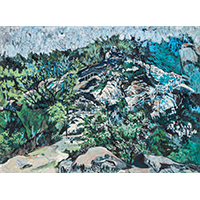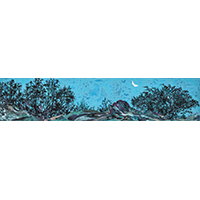Multi-Dimensional Lines Steering to Unknown Memories
The space of Kwon In Kyoung‘s [Imagined Memories] exhibition shows memories embedded in every layer and it appears vivid and obscure like a dream because each scene is strong and at the same time uncertain between scene and scene for causality. If the causal relations are clear, memories or dreams will be rationalized enough to be alive in reality and get meanings and functions. Such causal ring in her works however is omitted and piece and piece face away each other and go away everywhere where such randomness allows only consciousness to take the role of coordinator. The mediating part accepted in her works reveals wildness and frankness rather than sophistication or elegance. That strongly shows that she will follow her true nature even if she gets some benefits from her concentration on one thing in the labor-divided society.
In her works, dreams, unconsciousness and madness make a very strong flow but we cannot be sure that what directions they are going to take. They seem to comply with gravity but keep afloat like the planet earth in the space filled with blue. Vague but strong, it seems to have similarity with art and must be a choice heading for nature not for consciousness, reason or civilization. The forces that ramble all over the direction could be compared with water stream or tree images that suddenly come up in the canvas. In [Vague Space] of the modeling paste on photograph series, the canvas is covered with sophisticated mesh like a lace. The space of it is densely charged with something as if the terminal parts of the water or trees try to reach. One space is created for another memory to fill. Memory that proliferates like cell divisions does not confine itself just to its past representation. In this liquid world, to represent a fixed point is not possible. Even though such representation could be found in a very small scale, the shortly proliferated pieces will make it alienated.
‘Imagined Memories’ recalls the liquidity of memory and it does not tell a slow extinction of memory with time or some transformation of it. That is not a representation but a creation. In her works, memories not only belong to the past and the future but have the function of renewing here and now. The work came from a serious trauma she has. Aleida Assmann in his [Space of Memory] mentions the relations between shock and memory. For example, a concentration camp becomes the site for trauma because the brutality committed there exceeds understanding and expression humans can accept. A trauma which can be understood or expressed is no longer trauma. But the artist is not a 'patient' who is bad but a person who overcame illness, especially through art work. Contrary to the Oriental paintings that generally put importance on the beauty of empty space or to an organic system of order, her works connote paranoiac or schizophrenic elements but they are positive ones rather than negative ones. That is to say, there is a cheerful energy that recalls progress not escape there.
Of course, we could find the sense of loss. As the title of [Unintended Loss] shows, the ring of hurt-memory-sense of loss is revealed. But loss does not mean surely a hardship. As religious scholar Jonathan Smith mentions in his book of [To Take Place], we don't need to think loss is a sinking into the chaos of disharmony, corruption, not-being. Loss provides the starting point of a multiplicative process to coordinate and change the present remained. Through the transformative process, space·time lost moves from its original space to others-things, humans or a cover and therefore could be forever approachable. Once we take such perspective, space is not divided by already existing things and an empty space that is supposed to fill images used to call for memories. According to Jonathan Smith, space pre-exists and outlives memory, but it is not simply given too and rather created by the projection of man.
It means that space is not a passive vessel but an active product of transplant. To set up a direction is concerned with our body. Body establishes directions and gives a meaning to space. As shown in her work of [The mind map] series, psychological instructions are thus important. This viewpoint suggests that man is not given a space but rather determines the existence of space. Anyone has the memory of good and bad spaces. Good space can heal but bad one tends to make the situation worse. Even though space disappears, only there remains its memory. And especially the memory of space that fades away with time gets intense. A deep sense of loss becomes a power that makes the non-existent space an alternative to heal deficiency here and now. When we think over songs all the peoples on the globe had, that suggestion is reasonable. However, in reality, it is highly unlikely that their home does correspond with those songs.
By Jonathan Smith, home is not the most well understood site as my birth place or my living place. Home is the place for memory to stay and fantasies are condensed there. So, all the true space to live has the characteristics of home. Kwon In Kyoung has lived in an apartment for more than 30 years and the place may be considered as a home to her. Large scale residential spaces like apartments however gather people who have different homes, meaning that they are destined to have different memories even when living in the same place. Like dreams, unconsciousness, tastes or habitude, memory is regarded as a truly personal thing. And those distinctions should create different orientation. As shown in [Personal Room] series, each world has invisible walls. The walls may protect and alienate an individual. In her works, such disparate element positively acts like a polyphonous harmony. The criticism of apartment's uniformity is replaced by the stage of its new birth of difference. Apartment, as one of the important elements for the work, includes in it a realistic point of view of seemingly swallowing the older village down there and at the same time also forecasts differences.
Paradoxically, apartment becomes a place to identify differences from the process of repetition, because the architecture was built on the plan of the same model and the same period of construction. The combination of apartment and poor village tells the co-existence of different things and at the same time a kind of universality. In cities different things usually co-exist and it generates chaos and vitality, and such combination is actively introduced in her work. Two landscapes having different atmosphere and point of sight are connected up and down in [Simultaneous Space]. A small water stream connects the two spaces in it. The top and bottom of it have no organic mixture but are arranged in a row. In her works, one center or a hierarchical order cannot establish themselves, for space·time in relation to memory should be expressed, and it finally results in an endless variation heading towards a dynamic dimension instead of resting on a static space. The image of growing upward has the same trend too. [Extended Building] is inspired by a freakishly extended structure. Very strange, but such construction is being often witnessed in daily life.
The repeatedly constructed layers explain the progress of time of space. The extended building expresses such transformation in a synchronic structure like a side of time. Strange rocks between layers show this loose integration acquires strength. In other words, an entangled and extended structure even could take roots like old tress with time passing. In her works, inorganic substances grow like organisms. But that cannot be compared with the general pattern of organic growth. The screen of paints and collage mixed is perfect to create different species. On the bottom of [Unintended Loss] are strange rocks but the entirely different time is put on the top. With the addition of collage of records having different times to it, many gaps are created. The potential gaps in the work are emphasized by the speed difference when scenes are folding and unfolding alongside time. Like [Simultaneous Structure], it has some cities in a landscape. Those different things being co-existent, however, could be homogenized when we wait and see in the long distance.
The packed differences that fill up the space come out as a texture. And such viewpoint is well matched with empty chairs often seen in her work. In [The mind map 1], an empty chair outside is served to make houses in a map-like space look a lump. There are gaps between houses but they are smaller than gaps formed between houses and the chair when compared. The chair that hints an absent presence will be a space for someone who watches a city and urban life. In [The mind map 2], an empty chair on a hill looks down on houses being concentrated like the shape of a map as well. The nature arranged in and out of those structures relativizes a dense structure like the poor village on the hill or a concrete jungle. Hill, water, empty space or even uncolored blank all coexist with that tight structure. [Souvenirs] series have the blanks of dismantled canvas strands and it suggests memory is something unknown to be finished.
[Black out] inspired by tsunami which took place in Japan embodies memory lost. Such overall collapse overwhelms personal trauma and takes its place as a collective memory. Considering a close relation between place and memory, the loss of memory could also be compared with tsunami. The painting of thick-colored bricks indicates what role the remaining bricks have to take in order to rebuild the collapsed buildings. Bricks scattered here and there will link the different blocks of space·time like a stepping stone. Even if the gap between pieces is wide, that cannot be regarded as a loss and instead may be an opportunity for leap. Art is too the place something impossible really occurs. Events in art do not mean a realistic disaster. Gap is loss but expects continuity at the same time. In her works, a link continues from line to line, not from point to point. The image of line varies from a delicate crack to huge mountains to a water stream to a road to wire to a twig.
Windows and doors that are a structured line also play each role. They link here and there. In [Imagined Memories2], a bright line crossing the canvas is a window sill. There is no side that divides in and out of the window there. The line freely comes and goes here and there. Like the doors that move to another dimension, its role symbolizes the other world of the mirror. The fixed reality will not be exactly reproduced there. In [Imagined Memories3], the bright-lined and geometrically divided front of the screen indicates the inside and showing a landscape for the outside. But mountain and rocks suggest the inside and outside are connected together. A sun and a moon are located on two divided screens and two different time zones face like pieces of a crystal. It feels that a landscape with filled with something is about to pour out as soon as we open a door charged with things. But we cannot predict what will come out in her work where various elements are connected in different ways.
Deeply located windows have their own time, some reflecting daylight, others for the night. Sometimes they look like different pictures that are hung up on a wall, featuring picture in picture, landscape in landscape. A flowerpot beside the floor with the door opened looks down at us as if it is a human in [Two Doors]. The artist tells us that the pot resembles her. The flowerpot, alongside chairs, shares a sight the viewer takes when he/she faces landscape. They are not human but human's traces. In her works having both microscopic and macroscopic sense of space·time, humans simply appear as marks. Men are not a represented icon but are omnipresent as memory and perception in space·time. Pieces back to back, regardless of the general sense of space·time, make all the possible sights juxtaposed. And the sense of the parallel continuity of 'and' is modern. Segmental structures widespread in the works contain their own singular. Territories newly created with 'different singulars connected' (Gilles Deleuze) and pieces getting arranged move forward, tracing a map
Lee Seon Young (Art critic)
At the Entrance of Heartland-Utopia
Inkyung Kwon is an artist who expresses landscape through colored picture techniques. That landscape, however, is not of works that can be seen in traditional landscapes but ones made in a new way. Her works do not depend only on strokes of Indian ink or brushes. She also uses acrylic paint which was not adopted in traditional techniques and symbolizes temporality with collage of single pages from old books on a screen when composing a picture while various images drawn with montage technique upon it visualizes everyday thinking and experience surrounding the artist yet again, which composes a twofold collage screen.
In Kwon's works, unrealistic landscapes that cannot be explained with logic or reason are mixed in a single piece. Houses and shops that are spotted around the artist's life and buildings that the artist has visited or taken a look from far away are mixed with rocky mountains, trees, forests and asphalt roads while being put out of consistent time or proportion. Kwon often intentionally distorts buildings or landscapes to arrange in a piece to express an object as if it were described in drastic perspective to see it right in front of a skyscraper or as if it were seen through irregular and crooked lenses from above the sky. Scenes in her work do not stop here but furniture like chairs or tables that are likely to be in a room is added on that landscape once more and these scenes sometimes are suggested as landscapes overlooked through windows.
In Kwon's screens composed this way, there have frequently been waterways that surround or flow around landscapes like a moat. Indigo-colored water flowing around the screen of yellow tones separate space in the screen as contradistinctively as the colors' contrast effect. A blue river sometimes seems to divide this and that side and other times it seems to protect the space isolated with that water from outside invasions and serve as a buffer zone from threats.
The artist names the space created this way as Heartland. Interpreted as the 'heart' or the 'core,' Heartland is the center of mental thinking where one's heart focuses on its attention as well as the core on the geographical coordinate. Being collage of memories and imaginations, the visual images expressed here, therefore, imply that it is filled with elements composing the artist's psychological heartland so we need to read through those images like breaking a code.
Freud, an Austrian psychoanalyst in early 20th century, argued that he found some interesting facts through research on our humans' psychosexuality, anxiety, unconscious and subconscious. From one of his studies, he suggested the concept called defensive mechanisms as one of unconscious reactions to show a human's inner anxiety to the outside world. According to his theory, when we feel anxious in a given situation, we find it hard to control that anxiety in a rational and direct manner but we rather depend upon judgments and behavior based on unconscious. The defensive mechanism is one of self-preservation methods used to protect oneself from a risk of collapse by unconsciously avoiding actual anxiety and desires that come from our inner side.
Heartland that Kwon has built through her works is thought to reflect the human nature of self-preservation and pursuit of happiness toward utopian peace which is not to be shaken by any external stimuli or threats. On a step before entering this utopian land, however, we may suffer from ordeals that we cannot rid ourselves of worries to be exposed to anxiety and threats. Among her works, imaginary skyscrapers stood on a steep cliff or exotic buildings that seem to be on limited land with their surroundings sinking down may be to visually recall phases of psychological anxiety and ordeals overlooked from the artist's consciousness so far, as imagined from the title .
Kwon aims for Heartland now. The artist calls there 'a fortress which will not be ever shaken by any external factors.' The fortress, however, is not only topographically defensive any more. Rather, it would be a spiritual fortress armed with breadth of mind. As peeping into the possibility of Heartland little by little, she gradually opens up the topography of borders that have built defensive composition in works. Now a river does not surround but dances around and meanders through the artist's Heartland as if it protected it. The artist names this scene as . Like an attitude to contemplate objects before time as life experience deepens, now there are wide open rivers (or seas) from a distant view and faraway mountains beyond which are not threatening any more as components in the landscape the artist newly builds up. It is also seen that colors are better refined and the composition is neatly organized as well. Taking a closer look to screen, we can also see a small and shy church with cross, the symbol of salvation.
In Kwon's recent work , collages of old books, image montages, landscapes around the artist and arrangement of objects in dépaysement style that the artist has used so far are all expressed in a frame of oddly shaped stones or plants' silhouette that can be seen in traditional painting. This time, however, that space is replaced with shapes of towering rocks or plants growing greenly in flowerpots on the cobalt-colored background and the big, red flowers are so much conspicuous in them. Perhaps the artist may finally find out the entrance to Heartland.
Ha Kyehoon (Art critic)
Imagined memories
People create memories, anticipation and reminiscences from their location, specific space or object. The relationship between people and place, or people and objects can provoke deeply personal issues such as one’s ego, identity, personal history or memories. Through their personal events, memories, relationships, bonds, communication, and sympathy that occur in conjunction with their place and belongings, they get to experience a certain psychological effect.
People who have lost their house, space and belongings by an accident or fire, are subject to a deep and prolonged feeling of losing oneself entirely. This is because people get attached to space, specific location or belongings, and thus form an everyday life relationship with them and end up projecting themselves deep into these physical entities.
French author George Perec described and channeled his characters through their belongings, for the very reason that people's identities are best revealed through the space that they belong in. The Eskimos have a custom of licking objects that have newly come into their lives, because they recognize that an object is a part of a human. Mihaly Csikszentmihalyi's idea of how "things that surround us are inseparable from who we are" is a notion that reflects this concept.
People who suffered from traumatic experiences get invaded by such experiences and become emotionally unstable, to an extent that is unimaginable by the general public. These sufferers attempt to seek solace by creating their very own healing space or objects. This can take a form of a specific location, a familiar neighborhood or a house, a personal room or a certain object. In order to forget their trauma, they create an imagined experience which turns into a memory, and through repetition eventually turn into an actual experience. It is an effort to escape from the trauma by editing and reforming one's memory of the experience. Time and physical distance is overcome through a specific place or object, and the things become a pillar of support for memory. Sometimes one can even personify a location or an object, and one can also drag a memory or reminiscence into the realms of imagination. Even the people who have not suffered from actual emotional trauma tend to repeatedly visit a place of their fond childhood memory, or create their personal space into a unique world for themselves, in an attempt to pictorialize the trauma of reality.
Imaginification of memories occur in a small space, a corner, or the inner personal space, and they eventually manifest into reality. We strive to find our own home through an imaginative experience of space.
Kwon, In Kyoung- 2015, Work Statement for the 8th Private Exhibition






